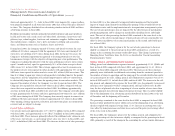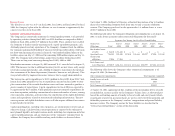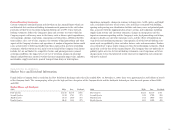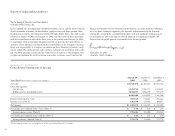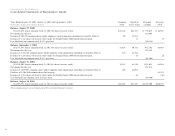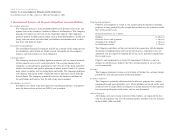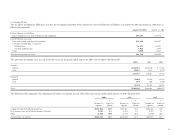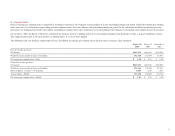Family Dollar 2003 Annual Report Download - page 29
Download and view the complete annual report
Please find page 29 of the 2003 Family Dollar annual report below. You can navigate through the pages in the report by either clicking on the pages listed below, or by using the keyword search tool below to find specific information within the annual report.
25
Vendor allowances:
In January 2003, the Emerging Issues Task Force (“EITF”) issued EITF 02-16,
“Accounting by a Customer (Including a Reseller) for Certain Consideration
Received from a Vendor.” Under this EITF, cash consideration received from
a vendor is presumed to be a reduction of the purchase cost of merchandise
and should be reflected as a reduction of cost of sales or revenue unless it can
be demonstrated this offsets an incremental expense, in which case it can be
netted against that expense. The provisions of this consensus have been applied
prospectively. The adoption of EITF 02-16 did not have a material impact on
the Company’s financial position or results of operations.
Store opening and closing costs:
The Company charges pre-opening costs against operating results when incurred.
For properties under operating lease agreements, the present value of any remain-
ing liability under the lease, net of expected sublease and lease termination
recoveries, is expensed when the closing has occurred.
Selling, general and administrative expenses:
Buying, warehousing and occupancy costs, including depreciation, are included
in selling, general and administrative expenses.
Income taxes:
The Company records deferred income tax assets and liabilities for the expected
future tax consequences of temporary differences between the financial report-
ing bases and the income tax bases of its assets and liabilities.
Stock options:
The Company accounts for stock-based compensation using the intrinsic value
method prescribed in Accounting Principles Board Opinion No. 25, “Accounting
for Stock Issued to Employees,” and related Interpretations. The exercise price
of options awarded under the Company’s non-qualified stock option plan has
been equal to the fair market value of the underlying common stock on the date
of grant. Accordingly, no compensation expense has been recognized for options
granted under the plan. Income tax benefits attributable to stock options exercised
are credited to capital in excess of par.
The Company utilizes the disclosure-only provisions of Statement of Financial
Accounting Standards No. 148, “Accounting for Stock-Based Compensation—
Transition and Disclosure.” If compensation cost for the Company’s stock-based
compensation plan had been determined based on fair value at the grant date
for awards under this plan consistent with the methodology prescribed under
this statement, net income and net income per share would have been reduced
to the pro forma amounts indicated in the table below (In thousands, except
per share amounts):
August 30, August 31, September 1,
2003 2002 2001
Net income—as reported $247,475 $216,929 $189,505
Pro forma stock-based compensation cost (5,988) (4,280) (3,458)
Net income—pro forma $241,487 $212,649 $186,047
Net income per share—as reported
basic $1.44 $1.26 $1.10
diluted $1.43 $1.25 $1.10
Net income per share—pro forma
basic $1.40 $1.23 $1.08
diluted $1.39 $1.22 $1.08
Fiscal year:
The Company’s fiscal year generally ends on the Saturday closest to August 31.
Fiscal years 2003 and 2002 included 52 weeks, and fiscal year 2001 included
53 weeks.
Use of estimates:
The preparation of the Company’s consolidated financial statements, in conform-
ity with accounting principles generally accepted in the United States of America,
requires management to make estimates and assumptions. These estimates and
assumptions affect the reported amounts of assets and liabilities, the disclosure
of contingent assets and liabilities at the date of the financial statements, and
the reported amounts of revenues and expenses during the reporting period.
Actual results could differ from these estimates.



